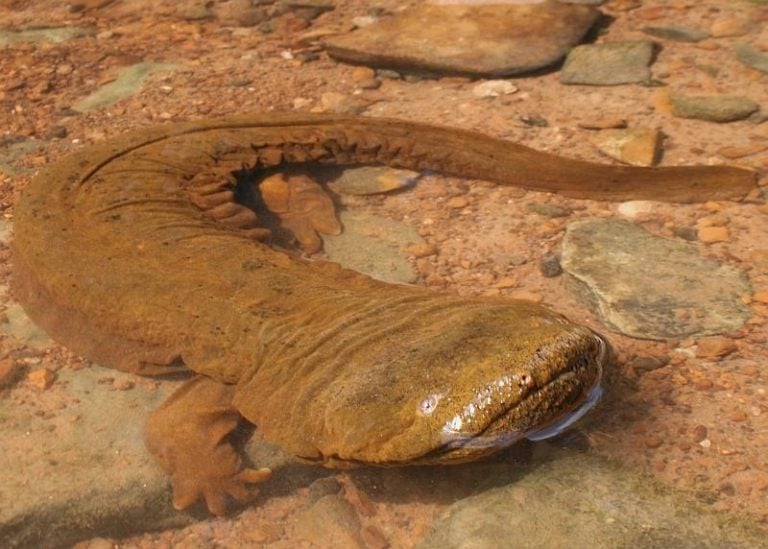Legal Victory Puts Hellbender Back on Track for Endangered Species Protection
By: Waterkeeper Alliance

In response to a lawsuit filed by five conservation groups, a federal judge found today that the U.S. Fish and Wildlife Service’s 2019 denial of Endangered Species Act protection for the eastern hellbender salamander was arbitrary and unlawful.
District Judge Lewis J. Liman set aside the Service’s decision and instructed the agency to make a new decision consistent with law. The lawsuit was filed by the Center for Biological Diversity, Waterkeeper Alliance, Lower Susquehanna Riverkeeper, Middle Susquehanna Riverkeeper and Waterkeepers Chesapeake.
“This ruling is a lifesaving victory for hellbenders and their declining freshwater habitats,” said Elise Bennett, a senior attorney at the Center for Biological Diversity. “The Fish and Wildlife Service can no longer ignore overwhelming scientific evidence that hellbenders are in danger of extinction and face even greater threats ahead. These odd and charming salamanders can survive, but they desperately need the help of the Endangered Species Act.”
The Service’s decision to deny protection to the hellbender was largely based on unproven, though laudable, population-augmentation efforts such as the use of artificial nest boxes or release of juvenile hellbenders raised in captivity from wild-caught eggs. In today’s ruling, the court found that the Service unlawfully relied on conservation measures that had not yet been implemented and determined effective and that did not address sedimentation, a primary threat to the species.
“There are few creatures as symbolically significant to our work in the Susquehanna River watershed as the eastern hellbender, a misunderstood and underappreciated species that is a critically important litmus test of water quality,” said John Zaktansky of Middle Susquehanna Riverkeeper. “It is estimated by local hellbender expert Dr. Peter Petokas that as much as 95% of their habitat in our nearby river system is gone due to a wide variety of issues. Erosion and sedimentation, abandoned mine drainage and other legacy pollutants combined with a wide spectrum of emerging contaminants likely continue to narrow the range of the hellbender and may soon choke it out of existence in our area without some sort of intervention. Today’s ruling helps take us back in the right direction to better protect a species that desperately deserves our recognition and protection.”
“The eastern hellbender was on its way to the brink of extinction, but not today, not ever,” said Ted Evgeniadis of Lower Susquehanna Riverkeeper Association. “Unchecked development and irresponsible use of our water resources has allowed their populations to decline but today’s decision gives this critical species another chance. We look forward to an official listing under the Endangered Species Act so that conservation efforts are expanded to support the life of the eastern hellbender.”
“The Trump administration’s refusal to federally protect the eastern hellbender was scientifically and legally indefensible, and we’re relieved that the federal court has now recognized the significant flaw in their analysis,” said Daniel E. Estrin, general counsel and legal director for Waterkeeper Alliance. “These unique amphibians have been suffering the proverbial death by a thousand cuts for decades as a result of water pollution, climate change, and encroachment on their limited habitat — all caused by humans. We implore the Fish and Wildlife Service to protect them and the cold, clean waterways they depend on to survive and propagate before it’s too late.”
“This is a great victory, not only for the hellbenders, but for all species that rely on clean, free-flowing streams and rivers. Hellbenders are like the canary in the coal mine. This ancient species is now almost gone from much of Appalachian streams because they are incredibly sensitive to pollutants and the destruction of their habitats when smothered by sediment,” said Robin Broder, acting executive director of Waterkeepers Chesapeake. “This ruling will save the hellbender and their diminishing freshwater habitats.”
In April 2019 the Service determined the eastern hellbender did not warrant Endangered Species Act protection, despite finding that nearly 80% of hellbender populations have already been lost or are in decline and that threats are likely to intensify. Hellbender declines are driven by dams and other impoundments, industrial and agricultural water pollution, deforestation, oil and gas development including enhanced recovery techniques such as hydraulic fracturing, residential development and mining.
Background
The hellbender was once widespread in 15 states but has been eliminated from much of its historic range. This salamander still lives from southern New York to northern Georgia and from the central Appalachians westward to Missouri; remaining populations are concentrated in the Ohio River watershed, the Tennessee and Kanawha river watersheds (both major tributaries to the Ohio River), and the Susquehanna River watershed. There’s also a population in Missouri.
Hellbenders are a completely aquatic species, commonly found in cool, highly oxygenated, perennial streams. Boulders, especially large, flat rocks, serve as nest rocks; they provide shelter and cover and are the most important indicator of adult hellbender habitat. Hellbenders breathe through their skin, but also have lungs they can use under some conditions.
Hellbenders are primarily nocturnal and move by walking on stream bottoms but can swim short distances to avoid predators. Their lifespan is estimated to be at least 25 to 30 years and may be closer to 50.
The eastern hellbender is known by colorful names like “devil dog,” “snot otter,” “Allegheny river monster,” “grampus” and “old lasagna sides” — nicknames that reference the loose, frilly skin along its sides and its mucus-like covering, which is believed to provide protection from abrasion and parasites and may have antibiotic properties. The hellbender is the largest salamander in North America and can grow longer than two feet.
The Center petitioned to protect eastern hellbenders under the Endangered Species Act in 2010. The October 2017 “not warranted” finding came after two legal agreements the Center entered into with the Fish and Wildlife Service in 2011 and 2013 to expedite protections.